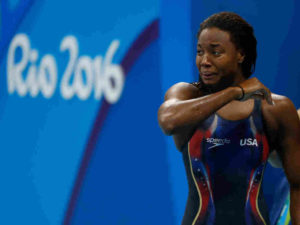
Simone Manuel after winning gold in 100 freestyle Rio 2016
Thursday night at the highly anticipated Rio Olympics, Stanford University swimmer Simone Manuel became the first African-American woman to ever win a medal in an individual swimming competition.
She didn’t win just any medal though; she tied for first place with Canadian swimmer Penny Oleksiak and snagged another gold for Team USA. Making the victory even sweeter, Manuel set a new record by completing the women’s 100 meter freestyle in just 52.70 seconds. Talk about Black girl magic.
“This medal is not just for me,” Manuel said fighting back tears in a post-swim interview. “It’s for a bunch of people who have come before me and have been an inspiration to me. And its for all the people after me who believe they can’t do it. I just want to be an inspiration to others that you can do it.”
While serving as a new source of inspiration for little Black boys and girls everywhere, the star swimmer’s Olympic feat also punched a massive hole in the all-too-common stereotypical belief that Black people can’t and/or don’t swim. Most people joke about Black folks’ inability to swim, but the numbers behind the phenomenon are worrisome. A 2010 study conducted by the University of Memphis and commissioned by USA Swimming revealed that nearly 68.9 percent of African-American children had “low or no swim ability.” Black children also die from accidental drownings at 5 1/2 times the rate of white children, according to the Centers for Disease Control and Prevention.
So, the significance of Manuel’s historic Thursday night win goes beyond negating a long-held racial stereotype; it served as encouragement for Black folk to go out and achieve something that society consistently told them they weren’t able to do.
Her victory was also a bitter reminder of a time when Black people were forcibly kept out of public swimming pools all across the Jim Crow South.
Swimming pools in general have long served as indicators of the racial climate in America; whether it be that iconic photo of a motel manager pouring acid in a whites-only pool as group of Black lodgers swam or Jackie Robinson’s harrowing experience of being held at gun point for taking a dip in a reservoir. TCM.com even reports that a hotel swimming pool was drained to prevent movie star Dorothy Dandridge from swimming in it.
According to the Washington Post, early signs of race (and class) segregation at swimming pools began rearing its ugly head in the late 19th and early 20th centuries. At the time, community pools were opened in large northern cities and served mostly poor and working-class boys, both Black and white. But a 1910 proposal to build a community pool in the middle of New York’s Central Park drew strong opposition from the city’s middle and upper-class residents who feared that the new amenity would attract “all sorts of undesirable people,” the publication reports.
Pool designs and social norms also began evolving in the 1920s and ’30s, as big cities started building resort-style pools that welcomed both male and female swimmers. However, with gender integration came racial segregation. Per the Washington Post, white public officials didn’t think it was appropriate for Black men to interact with white women in such “visually and physically intimate” spaces. Cue the beginning of racially segregated pools throughout the northern United States.
The idea of “whites only” swimming pools eventually made its way to the South, as public officials mandated a separation of the races through Jim Crow laws. African-Americans swimmers were then explicitly barred from wading in pools specifically designated for white people.
Despite the desegregation of public pools after World War I, many whites fought hard to keep things separate by repelling Black swimmers. For instance, the Washington Post reports that Southern cities usually shut down their community pools, rather than have racially integrated swimming. Meanwhile, in the North, pools were drained or abandoned as white people retreated to ones in white neighborhoods or swam in private pools where segregation was still permitted.
According to Vox, the battle for integration ensued well into the 1950’s, as the NAACP was involved in a number of anti-discrimination lawsuits due to the fact that African-Americans were still being denied access to public swimming pools and beaches.
The most recent incident of race discrimination took place in 2009 when 65 Black and Latino campers from the Creative Steps day camp in North Philadelphia showed up to the suburban Valley Swim Club in Montgomery County. Per the Washington Post, regular club goes began pulling their children from the pool as the campers hopped in, audibly questioning why so many Black and Latino kids were suddenly at their pool. Camp director Althea Wright had already paid the private club $1,950 to use the facility; but few days later, the Valley Swim Club terminated their lease agreement. When asked why, the club president explained that, “there was concern [among the members] that a lot of kids would change the complexion … and the atmosphere of the club,” the publication reports.
The long, dark history of racism and discrimination at America’s swimming pools is all the more reason fans across the country celebrated the historic win for Manuel. Although these incidents of bigotry predate the Olympic gold athlete, her victory is a symbol of triumph that goes far beyond the swimming pool.


